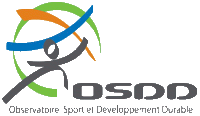
 |

|

|

|
 |
 |
Sport + Environnement + Social + Économie |  |
 |
Accueil | Plan | Recherche Mot | Recherche Auteur | Statistiques | Nos actions | Bienvenue sur Sport Durable |  |
 |
Un sport sain dans un corps sain dans un territoire sain |  |
 |
|
Accueil > Environnement > Sport et environnement
The Connection between Sport and Environment Impact of sports on environment Impact of the environment on sport Imagine the following : what impact will the thinning of the ozone layer have on an athlete’s performance ? Will it mean wearing hats, sunglasses and repeated doses of sunblock for those who practice outdoors ? Will it lead to higher incidences of skin cancer or cataracts ? What impact has air pollution on sportsmen/women ? You probably have many answers to this and many other questions on the impact of the environment on sport. SPORT as an Opportunity to promote environmental awareness * Promoting green games UNEP AND THE OLYMPIC GAMES UNEP and the International Olympic Committee (IOC) signed a Co-operative Agreement in February 1994, in which both organizations agreed to jointly undertake international actions to promote sustainable development. As a result of this commitment by the IOC : 1. The environment became the third dimension of olympism alongside sport and culture. A Sport and Environment Commission was created in the IOC to advise the Executive Board on policies necessary for environmental protection. UNEP plays an important role in this Commission which meets regularly to review the integration of environmental considerations in Olympic events. The 1994 Winter Olympic Games in Lillehammer, Norway set new standards for mega-sports events. It ensured that future sport events would be required to include environmental measures as part of their basic mandates. The Lillehammer Olympic Organizing Committee received the UNEP Global 500 Award in 1994 for setting environmental standards, which were absent from previous Olympic games. Environmental Guidelines for the Summer Olympics were developed to guide Olympic hosts to ensure that the construction of facilities is done in a more environmentally friendly manner. The Guidelines were successfully used in the Sydney Olympic Games. As a result, the organizers of the Sydney Games were honoured with the Global 500 Award in 2001 for organizing the greenest games ever. Agenda 21 for Sport and Environment. A sustainable development agenda for sport was developed and adopted in 1999. A UNEP/IOC Working Group has been established to provide advice and guidance on and to monitor the implementation of the Agenda. World Conferences on Sport and Environment is organized every two years by the IOC with the support of UNEP. The last World Conference was held in Nagano, Japan from 3 to 4 November 2001. The World Conference brings together major sports stakeholders of the Olympic Movement to review the implementation for the agenda 21 for Sport and Environment and to discuss environmental issues related to preparations of upcoming Olympic games. The Connection UNEP & Global Sports Alliance Nature & Sports Training Camps Tennis Forum for Global Voir en ligne : spip.php?site0 |
 |
|||||||||||||||||||||||||||||||||||||||||||||||||||||||||||||||||||||||||||||||||||||||||||||||||||||||||||||||||||||||||||||||||||||||||||||||||||||||||||||||||||||
 |
Copyright
© 2006 Sport Durable |
PIWIK
|
|
PIWIK
|
|
 |
 |